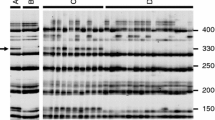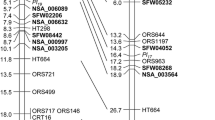Abstract
Commercial hybrids of cultivated sunflower (Helianthus annuus L.) are obtained by crossing a cytoplasmic male sterile line (A-line) with a restorer pollinator (R-line). The incorporation of a recessive branching trait to extend the pollination period of R-lines during hybrid seed production is laborious and time-consuming. By using target region polymorphism (TRAP) and bulked segregant analysis (BSA), we identified 15 TRAP markers linked to the b 1 (branching) locus in a population of 229 F2 plants derived from a cross between nonbranched (HA 234) and branched (RHA 271) lines. TBr4-720 and TBr8-555 markers were linked to the b 1 gene in the coupling phase at 0.5 cM (0.004 recombination frequency). The Tbr20-297 and Tbr20-494 markers flanked the b 1 locus in the repulsion phase at genetic distances of 7.5 and 2.5 cM, respectively. Tbr19-395, also in the repulsion phase, mapped at 3.8 cM from the b 1 locus and on the opposite side of the marker Tbr20-297. The 8A1 and 15B3 restriction fragment length polymorphic (RFLP) markers of linkage group (LG) 16 of the RHA 271 × HA 234 cultivated sunflower map anchored the b 1 LG onto the RFLP map. Polymerase chain reaction (PCR)-based markers tightly linked to the recessive b 1 gene have been developed. Their identification and the incorporation of the LG containing the b 1 locus onto an RFLP map will be useful for marker-assisted selection (MAS) in breeding programs and provide the bases for map-based cloning of this gene.


Similar content being viewed by others
References
Bendahmane A, Kanyuka K, Baulcombe DC (1997) High-resolution genetical and physical mapping of the Rx gene for extreme resistance to potato virus X in tetraploid potato. Theor Appl Genet 95:153–162
Berry ST, Allen RJ, Barnes SR, Caligari PDS (1994) Molecular marker analysis of Helianthus annuus L. 1. Restriction fragment length polymorphism between inbred lines of cultivated sunflower. Theor Appl Genet 89:435–441
Berry ST, Leon AJ, Peerbolte R, Challis C, Livini C, Jones R, Feingold S (1997) Presentation of the Advanta sunflower RFLP linkage map for public research. In: Proceedings of 19th sunflower research workshop, Fargo, ND. National Sunflower Association, Bismarck, pp 113–118
Bert PF, Jouan I, Tourvieille de Labrouhe D, Seere F, Nicolas P, Vear F (2002) Comparative genetic analysis of quantitative traits in sunflower (Helianthus annuus L.) 1. QTL involved in resistance to Sclerotinia sclerotiorum and Diaporthe helianthi. Theor Appl Genet 105:985–993
Bert PF, Jouan I, Tourvielle de Labrouche D, Serre F, Philippon J, Nicolas P, Vear F (2003) Comparative genetic analysis of quantitative traits in sunflower (Helianthus annuus L.). 2. Characterization of QTL involved in developmental and agronomic traits. Theor Appl Genet 107:181–189
Booker J, Auldridge M, Wills S, McCarty D, Klee H, Leyser O (2004) MAX3/CCD7 is a carotenoid cleavage dioxygenase required for the synthesis of a novel plant signaling molecule. Curr Biol 14:1232–1238
Brigneti G, Garcia-Mas J, Baulcombe DC (1997) Molecular mapping of the potato virus Y resistance gene Rysto in potato. Theor Appl Genet 94:198–203
Brinkman MA, Frey KJ (1977) Yield component analysis of oat isolines that produce different grain yield. Crop Sci 17:165–168
Burke JM, Tang S, Knapp SJ, Rieseberg LH (2002) Genetic analysis of sunflower domestication. Genetics 161:1257–1267
Chahal GS, Gosal SS (2002) Principles and procedures of plant breeding, biotechnological and conventional approaches. Alpha Science International, Pangbourne, pp 457–485
Chen J, Hu J, Vick BA, Jan CC (2006) Molecular mapping of a nuclear male-sterility gene in sunflower (Helianthus annuus L.) using TRAP and SSR markers. Theor Appl Genet 113:122–127
Chen X, Faris JD, Hu J, Stack RW, Adhikari T, Elias EM, Kianian SF, Cai X (2007) Saturation and comparative mapping of a major Fusarium head blight resistance QTL in tetraploid wheat. Mol Breed 19:113–124
Dedio W (1980) Comparison of achene characteristics and combining ability of branching and non-branching near-isogenic sunflower restorer lines. Crop Sci 20:189–190
Doebley J, Stec A, Hubbard L (1997) The evolution of apical dominance in maize. Nature 386:485–488
Doust AN, Devos KM, Gadberry MD, Gale MD, Kellogg EA (2004) Genetic control of branching in foxtail millet. Proc Natl Acad Sci USA 101:9045–9050
Fehr WR (1987) Principles of cultivar development, vol 1. theory and technique. Macmillan, New York
Fick GN, Miller JF (1997) Sunflower breeding. In: Schneiter AA (ed) Sunflower technology and production. Agronomy Monographs No. 35. ASA, CSSA, and SSSA, Madison, Wisconsin, pp 395–439
Fick GN, Zimmer DE, Zimmerman DC (1974) Correlation of seed oil content in sunflowers with other plant and seed characteristics. Crop Sci 14:755–757
Frisch M, Melchinger AE (2001) The length of the intact donor chromosome segment around a target gene in marker-assisted backcrossing. Genetics 157:1343–1356
Frisch M, Bohn M, Melchinger AE (1999) Comparison of selection strategies for marker-assisted backcrossing of a gene. Crop Sci 39:1295–1301
Gedil MA, Wye C, Berry S, Segers B, Peleman J, Jones R, Leon A, Slabaugh MB, Knapp SJ (2001) An integrated restriction fragment length polymorphism-amplified fragment length polymorphism linkage map for cultivated sunflower. Genome 44:213–221
Gentzbittel L, Zhang YX, Vear F, Griveau B (1994) RFLP studies of genetic relationships among inbred lines of the cultivated sunflower, Helianthus annuus L.: evidence for distinct restorer and maintainer germplasm pools. Theor Appl Genet 89:419–425
Gentzbittel L, Vear F, Zhang YX, Berville A (1995) Development of a consensus linkage RFLP map of cultivated sunflower (Helianthus annuus L.). Theor Appl Genet 90:1079–1086
Gentzbittel L, Mestries E, Mouzeyar S, Mazeyrat F, Badaoui S, Vear F, Tourvieille de Labrouhe D, Nicolas P (1999) A composite map of expressed sequences and phenotypic traits of the sunflower (Helianthus annuus L.) genome. Theor Appl Genet 99:218–234
Hockett EA, Knowles PF (1970) Inheritance of branching in sunflowers, Helianthus annuus L. Crop Sci 10:432–436
Hu J, Vick BA (2003) Target region amplification polymorphism: a novel marker technique for plant genotyping. Plant Mol Biol Rep 21:289–294
Hu J, Chen J, Gulya TJ, Miller JF (2004) Trap markers for a sunflower downy mildew resistance gene from a new Helianthus annuus source, PI 468435. In: Proceedings of the 16th International Sunflower Conference, 29 August–2 September 2004, Fargo, North Dakota, vol 2. International Sunflower Association, Paris, pp 623–629
Hu J, Ochoa OE, Truco MJ, Vick BA (2005) Application of the TRAP technique to lettuce (Lactuca sativa L.) genotyping. Euphytica 144:225–235
Jan CC, Vick BA, Miller JF, Kahler AL, Butler ET III (1998) Construction of an RFLP linkage map for cultivated sunflower. Theor Appl Genet 96:15–22
Johnson E, Miklas PN, Stavely JR, Martinez-Cruzado JC (1995) Coupling- and repulsion-phase RAPDs for marker assisted selection of PI 181996 rust resistance in common bean. Theor Appl Genet 90:659–664
Jouan I, Bert PF, Cambon F, Perrault A, Tourvieille de Labrouhe D, Nicolas P, Vear F (2000) The relations between the recessive gene for apical branching (b1) and some disease resistance and agronomic characters. In: Proceedings of the 15th international sunflower conference, Toulouse, pp K54–K59
Kelly JD, Miklas PN (1998) The role of RAPD markers in breeding for disease resistance in common bean. Mol Breed 4:1–11
Kosambi DD (1944) The estimation of map distances from recombination values. Ann Eugen 12:172–175
Kovacik A, Skaloud V (1990) Results of inheritance evaluation of agronomically important traits in sunflower. Helia 13:41–46
Lander ES, Green P, Abrahamson J, Barlow H, Daly M, Lincoln S, Newbury L (1987) MAPMAKER: an interactive computer program for constructing genetic maps of experimental and natural populations. Genomics 1:174–175
Leclercq P (1969) Une stérilité mále cytoplasmique chez le tournasol. Ann Amélior Plantes 19(2):99–106
Li X, Qian Q, Fu Z, Wang Y, Xiong G, Zeng D, Wang X, Liu X, Teng S, Hiroshi F, Yuan M, Luo D, Han B, Li J (2003) Control of tillering in rice. Nature 422:618–621
Miller JF, Fick GN (1997) The genetics of sunflower. In: Schneiter AA (ed) Sunflower technology and production. Agronomy Monographs No. 35. ASA, CSSA, and SSSA, Madison, Wisconsin, pp 441–495
Mercy TC, Knapp SJ (1998) Ancestral origins and genetic diversity of cultivated sunflower: coancestry analysis of public germplasm. Crop Sci 38:1476–1482
Mestries E, Gentzbittel L, Tourvielle de Labrouhe D, Nicolas P, Vear F (1998) Analyses of quantitative trait loci associated with resistance to Sclerotinia sclerotiorum in sunflowers (Helianthus annuus L.) using molecular markers. Mol Breed 4:215–226
Michelmore RW, Paran I, Kesseli RV (1991) Identification of markers linked to disease-resistance genes by bulked segregant analysis: a rapid method to detect markers in specific genomic regions by using segregating populations. Proc Natl Acad Sci USA 88:9828–9832
Otsuga D, Guzman B, Prigge MJ, Drews GN, Clark SE (2001) REVOLUTA regulates meristem initiation at lateral positions. Plant J 25:223–236
Putt ED (1964) Recessive branching in sunflowers. Crop Sci 4:444–445
Rogers SO, Bendich AJ (1985) Extracting DNA from milligram amounts of fresh, herbarium, and mummified plant tissues. Plant Mol Biol 5:69–76
Rozen S, Skaletsky HJ (2000) Primer3 on the WWW for general users and for biologist programmers. In: Krawetz S, Misener S (eds) Bioinformatics methods and protocols: methods in molecular biology. Humana Press, Totowa, pp 365–386
Schmitz G, Tillmann E, Carriero F, Fiore C, Cellini F, Theres K (2002) The tomato Blind gene encodes a MYB transcription factor that controls the formation of lateral meristems. Proc Natl Acad Sci USA 99:1064–1069
Schumacher K, Schmitt T, Rossberg M, Schmitz G, Theres K (1999) The Lateral suppressor (Ls) gene of tomato encodes a new member of the VHIID protein family. Proc Natl Acad Sci USA 96:290–295
Seiler GJ, Gulya TJ (2004) Exploration for wild Helianthus species in North America: Challenges and opportunities in the search for global treasures. In: Proceedings of 16th international sunflower conference, 29 August–2 September 2004, Fargo, ND, vol 1. International Sunflower Association, Paris, pp 43–68
Sorefan K, Booker J, Haurogné K, Goussot M, Bainbridge K, Foo E, Chatfield S, Ward S, Beveridge C, Rameau C, Leyser O (2003) MAX4 and RMS1 are orthologous dioxygenase-like genes that regulate shoot branching in Arabidopsis and pea. Genes Dev 17:1469–1474
Stirnberg P, Sande K, Leyser HMO (2002) MAX1 and MAX2 control shoot lateral branching in Arabidopsis. Development 129:1131–1141
Takeda T, Suwa Y, Suzuki M, Ueguchi-Tanaka M, Ashikari M, Matsuoka M, Ueguchi C (2003) The OsTB1 gene negatively regulates lateral branching in rice. Plant J 33:513–520
Tang S, Yu JK, Slabaugh MB, Shintani DK, Knapp SJ (2002) Simple sequence repeat map of the sunflower genome. Theor Appl Genet 105:1124–1136
Tang S, Knapp SJ (2003) Microsatellites uncover extraordinary molecular genetic diversity in Native American land races and wild populations of cultivated sunflower. Theor Appl Genet 106:990–1003
Tang S, Leon A, Bridges WC, Knapp SJ (2006) Quantitative trait loci for genetically correlated seed traits are tightly linked to branching and pericarp pigment loci in sunflower. Crop Sci 46:721–734
Tanksley SD, Young ND, Paterson AH, Bonierbale MW (1989) RFLP mapping in plant breeding: new tools for an old science. Biotechnology 7:257–264
Tantikanjana T, Yong JWH, Letham DS, Griffith M, Hussain M, Ljung K, Sandberg G, Sundaresan V (2001) Control of axillary bud initiation and shoot architecture in Arabidopsis through the SUPERSHOOT gene. Genes Dev 15:1577–1588
Voorrips RE (2002) MapChart: software for the graphical presentation of linkage maps and QTL. J Hered 93:77–78
Yu JK, Tang S, Slabaugh MB, Heesacker A, Cole G, Herring M, Soper J, Han F, Chu WC, Webb DM, Thompson L, Edwards KJ, Berry S, Leon A, Olungu C, Maes N, Knapp SJ (2003) Towards a saturated molecular genetic linkage map for cultivated sunflower. Crop Sci 43:367–387
Acknowledgments
This work was supported by a postdoctoral grant to P.R.B. from the Spanish Secretary of Education and Universities, and the European Social Fund. The authors thank Dr. Jose Luis Gonzalez and Dr. Dennis J. Tobias for their assistance, valuable advice and suggestions throughout this work. Authors also thank Lisa Brown and Angelia Hogness for their technical assistance in the greenhouse and laboratory.
Author information
Authors and Affiliations
Corresponding author
Additional information
Communicated by M. Xu.
Rights and permissions
About this article
Cite this article
Rojas-Barros, P., Hu, J. & Jan, C.C. Molecular mapping of an apical branching gene of cultivated sunflower (Helianthus annuus L.). Theor Appl Genet 117, 19–28 (2008). https://doi.org/10.1007/s00122-008-0748-9
Received:
Accepted:
Published:
Issue Date:
DOI: https://doi.org/10.1007/s00122-008-0748-9




